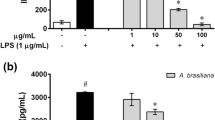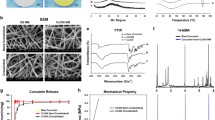Abstract
Wound healing consists of an orderly progression of events that re-establish the integrity of the damaged tissue. Several natural products have been shown to accelerate the healing process. The present investigation was undertaken to determine the role of curcumin on changes in collagen characteristics and antioxidant property during cutaneous wound healing in rats. Full-thickness excision wounds were made on the back of rat and curcumin was administered topically. The wound tissues removed on 4th, 8th and 12th day (post-wound) were used to analyse biochemical and pathological changes. Curcumin increased cellular proliferation and collagen synthesis at the wound site, as evidenced by increase in DNA, total protein and type III collagen content of wound tissues. Curcumin treated wounds were found to heal much faster as indicated by improved rates of epithelialisation, wound contraction and increased tensile strength which were also confirmed by histopathological examinations. Curcumin treatment was shown to decrease the levels of lipid peroxides (LPs), while the levels of superoxide dismutase (SOD), catalase (CAT), glutathione peroxidase (GPx), activities were significantly increased exhibiting the antioxidant properties of curcumin in accelerating wound healing. Better maturation and cross linking of collagen were observed in the curcumin treated rats, by increased stability of acid-soluble collagen, aldehyde content, shrinkage temperature and tensile strength. The results clearly substantiate the beneficial effects of the topical application of curcumin in the acceleration of wound healing and its antioxidant effect.
Similar content being viewed by others
References
Micera AE, Vigneti D, Pickholtz, R, Rerch Q, Pappo S, Bonini FX, Maguart L, Aloe F Levi-Schaffer: Nerve growth factor displays stimulatory effects on human skin and lung fibroblasts, demonstrating a direct role for this factor in tissue repair. Proc Natl Acad Sci U. S. A. 11: 6162–6167, 2001
Suguna L, Chandrakasan G, Joseph KT: Influence of honey on biochemical and biophysical parameters of wounds in rats. J Clin Biochem and Nutrition 14: 91–99, 1999
Sharma SP, Aithal KS, Srinivasan KK, Udupa Al, Kumar V, Kulkarni DR, Rajagopal PK: Anti-inflammatory and wound-healing activities of the crude alcoholic extracts and flavanoids of Vitex leucoxylon. Fitoterapia 61: 263–265, 1990
Chithra P, Suguna L, Chandrakasan G: Influence of arginine in wound healing in rats. J Clin Biochem and Nutrition 18: 111–117, 1995
Stravic B: Antimutagens and anticarcinogens in foods. Food Chem and Toxicol 32: 79–90, 1994
Ammon HP, Wahl MA: Pharmacology of Curcuma longa. Planta Medica 57: 1–7, 1991
Ruby AJ, Kuttan G, Babu KD, Rajasekharan KN, Kuttan R: Antitumour and antioxidant activity of natural curcuminoids. Cancer Letters 94: 79–83, 1995
Swarnakar S, Ganguly K, Kundu P, Banerjee A, Maity P, Sharma AV: Curcumin regulates expression and activity of matrix metalloproteinases 9 and 2 during prevention and healing of indomethacin-induced gastric ulcer. J Biol Chem 280: 29988, 2005
Sidhu GS, Singh AK, Thaloor D, Banaudha KK, Patnaik GK, Srimal RC, Maheshwari RK: Enhancement of wound healing by curcumin in animals. Wound Repair and Regen 6: 167–177, 1998
Suguna L, Surjeet Singh, Sivakumar P, Chandrakasan G: Influence of Terminalia chebula on dermal wound healing in rats. Phyto Res 16: 227–231, 2002
Porat S, Roussa, M, Shosan, S: Improvement of the gliding functions of flexor tendons by topically applied enriched collagen solution. J Bone and Joint Surg 62: 208, 1980
Burton K: A study of the conditions and mechanism of the diphenylamine reaction for the colorimetric estimation of deoxyribonucleic acid. Biochem J 62: 315–323, 1956
Lowry OH, Rosebrough NJ, Farr L, Randall, RT: Protein measurement with the Folin phenol reagent. J Bio Chem 193: 265–276, 1951
Woessner JR Jr: The determination of hydroxy proline in tissue and protein samples containing small proportions of this imino acid. Archv Biochem Biophys 93: 440–447, 1979
Elson LA, Morgon WTJ: A colorimetric method for the determination of glucosamine and chondrosamine. Biochem J 27: 1824–1828, 1933
Schiller S, Slover G, & Dorfman AA: A new perspective with particular reference to ascorbic acid deficiency. J Biol Chem 36: 983–985, 1961
Santos MT, Valles J, Aznar J, Vilches J: Determination of plasma malondialdehyde-like material and its clinical application in stroke patients. J Clin Path 33: 973–976, 1980
Piez KA: The amino acid chemistry of some calcified tissues. Annals of New York Academy Science 109: 256–268, 1963
Hering TM, Marchant RE, Anderson JM: Type V collagen during granulation tissue development. Exp Mol Path 39: 219–229, 1983
Adam, Fietzek P, Kuhn, K: Investigations on the reaction of metals with collagen in vivo. 2. The formation of cross-links in the collagen of lathyritic rats after gold treatment in vivo. Euro J of Biochem 3: 411–414, 1968.
Paz MA, Blumenfeld OO, Rojkind M, Henson E, Furfine C, Gallop PM: Determination of carbonyl compounds with n-methyl benzothiazolone hydrazone. Archives Biochem Biophys 109:548–559, 1965
Misra HP, Fridovich I: The generation of superoxide radical during the autoxidation of hemoglobin. J Biol Chem 247: 6960–6972, 1972
Aebi H, Scherz B, Ben-Yoseph Y, Wyss SR: Dissociation of erythrocyte catalase into subunits and their re-association. Experientia1 5: 397–399, 1975
Rotruck, JT, Pope, AL, Gauther, HE, Swanson, AB, Hafeman, DG, Hoeksthna, WG: Biochemical roles as a component of glutathione peroxidase. Scienceb179: 588–590, 1973
Vogel HG: Studies on dermal wound healing in experimentally injured rats. Biochimica et Biophysica Acta 252: 580–582, 1971
Nutting GC, Borasky R: Microscopic methods for determining shrinkage temperature of collagen and leather. Journal of American Leather Chemists Association 44: 831–839, 1949
Skalli O, Gabbiani G. The biology of the myofibroblast relationship to wound contraction and fibrocontractive disease. In RAF Clark, PM Henson (eds). The molecular and cellular biology of wound repair, Plenum Press, New York: pp. 373–402, 1988
Irvin TT: Wound healing. Arch Emerg Med 2: 3–10, 1985
Peacock EE: Contraction. In EE Peacock (ed). Wound Repair, ed. 3, Saunders, Philadelphia: pp. 39–55, 1984
Rudolph R, Berg JV, Ehrlich HP. Wound contraction and scar contracture. In: IK Cohen, RF Diegelman, WJ Lindbad (eds). Wound healing: biochemical and clinical aspects, Saunders, Philadelphia: pp. 96–114, 1992
Desmouliere A, Geinoz A, Gabbiani F, Gabbiani G. Transforming growth factor-a induces a-smooth muscle actin expression in granulation tissue myofibroblasts and in quiescent and growing cultured fibroblasts. J Cell Biol 122: 103–111, 1993
Dunphy JE, Udupa KN: Chemical and histochemical sequences in the normal healing of wounds. N Eng J Med 253: 847–852, 1956a
Hu M, Sebelman EE, Cao Y, Chang J, Hentz VR: Three dimensional hyaluronic acid grafts promote wound healing and reduce scar formation in skin incision wounds. J Biomed Mater Res 67: 586–592, 2003
Nithya M, Suguna L, Rose C: The effect of nerve growth factor on the early responses during the process of wound healing. Biochim Biophys Acta 1620: 25–31, 2003
Dunphy JE, Udupa KN: Wound healing. A new perspective with particular reference to ascorbic acid deficiency. Annals of Surgery 144: 304–316, 1956b
Siegel RC: Collagen crosslinking: Synthesis of collagen crosslinks in vitro with highly purified lysyl oxidase. J Biol Chem 251: 5786–5792, 1976
Stimler NP, Tanzer ML: Cross linking in biochemistry of collagen. In: GN Ramachandran, AH Reddi (eds). Plenum Press, New York: pp. 137–162, 1976
Barnes, MJ, Morton, LF, Bennet, RC, Bailey, AJ, Sims TJ: Presence of Type III collagen in Guinea pig dermal scar. Biochem J 157: 163–172, 1976
Bazin S, Delauray A: Biochemistry of inflammation. VI. Changes in the levels of collagen and nonfibrillar proteins in different kinds of inflammation. Ann Invest Pasteur 107: 163–, 1964
Rao CN, Rao VH, Sanjeevi R: Effect of bioflavanoids on the mechanical and thermal properties of skin and tendon. Ind J Biochem Biophys 18: 224–228, 1981
Nohl H: Generation of superoxide radicals as byproduct of cellular respiration. Ann Biol Clin (Paris) 52: 199–204, 1994
Senel O, Cetinkale O, Ozbay G, Ahcioglu F, Bulan R: Oxygen free radicals impair wound healing in ischemic rat skin. Annals of Plastic Surgery 39: 516–523, 1987
Agaev AIu, Nikolaev AV, Abasov BKh, Mamedov LA, Zakharov VV, Bashirov EA, Bagirov GS: Antioxidant therapy of purulent wounds in animal experiments 108: 35–37, 1989
Packer L, Landvik S: Vitamin E: introduction to biochemistry and health benefits. Annals New York Academy Sci 570: 1–6, 1989
Phan TT, See P, Lee ST, Chan SY: Protective effects of curcumin against oxidative damage on skin cells in vitro: Its implications for wound healing. J Trauma 51: 927–931, 2001
Wright JS: Predicting the antioxidant activity of curcumin and curcuminoids. J Mol Struc 591: 207–217, 2002
Pan M, Huang T, Lin J: Biotransformation of curcumin through reduction and glucuronidation in mice. Drug Metab Dispos 27: 486–494, 1999
Author information
Authors and Affiliations
Corresponding author
Additional information
Both the authors have contributed equally towards this paper.
Rights and permissions
About this article
Cite this article
Panchatcharam, M., Miriyala, S., Gayathri, V.S. et al. Curcumin improves wound healing by modulating collagen and decreasing reactive oxygen species. Mol Cell Biochem 290, 87–96 (2006). https://doi.org/10.1007/s11010-006-9170-2
Received:
Accepted:
Published:
Issue Date:
DOI: https://doi.org/10.1007/s11010-006-9170-2




